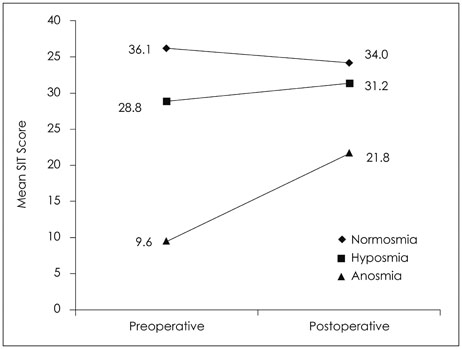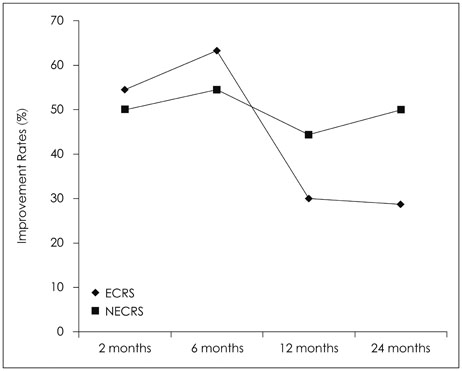J Rhinol.
2018 Nov;25(2):63-68. 10.18787/jr.2018.25.2.63.
The Predictive Factors of Olfactory Changes after Endoscopic Sinus Surgery
- Affiliations
-
- 1Department of Otorhinolaryngology-Head and Neck Surgery, School of Medicine, Catholic University of Daegu, Daegu, Korea. miky@cu.ac.kr
- KMID: 2431217
- DOI: http://doi.org/10.18787/jr.2018.25.2.63
Abstract
- Olfactory dysfunction is one of the most common complaints of patients with chronic rhinosinusitis. Patients who suffer from olfactory dysfunction report a negative effect on their overall quality of life. Chronic rhinosinusitis-related olfactory impairment is the most treatable form of olfactory disorder; however, outcomes after endoscopic sinus surgery (ESS) are challenging to predict. Previous studies have documented a wide range in overall improvement after ESS. The purpose of this study is to review the factors that predict changes in olfaction after ESS.
Figure
Reference
-
1. Raviv JR, Kern RC. Chronic sinusitis and olfactory dysfunction. Otolaryngol Clin North Am. 2004; 37(6):1143–1157.
Article2. Kim BG, Oh JH, Choi HN, Park SY. Simple assessment of olfaction in patients with chronic rhinosinusitis. Acta Otolaryngol. 2015; 135(3):258–263.
Article3. Yoon HC, Kim TM, Joo JW, Song IS, Hong S-N, Yoo JH, et al. The impact of nasal polyposis on olfactory dysfunction in chronic rhinosinusitis. J Rhinol. 2017; 24(1):31–36.
Article4. Choi SH, Kim ST, Park HM, Moon KH, Jung JH, Cha HE. Analysis of characteristics and steroid effects in olfactory dysfunction patients. J Rhinol. 2016; 23(1):39–43.
Article5. Soler ZM, Sauer DA, Mace JC, Smith TL. Ethmoid histopathology does not predict olfactory outcomes after endoscopic sinus surgery. Am J Rhinol Allergy. 2010; 24(4):281–285.
Article6. Hsu CY, Wang YP, Shen PH, Weitzel EK, Lai JT, Wormald PJ. Objective olfactory outcomes after revision endoscopic sinus surgery. Am J Rhinol Allergy. 2013; 27(4):96–100.
Article7. Kim BG, Kang JM, Shin JH, Choi HN, Jung YH, Park SY. Do sinus computed tomography findings predict olfactory dysfunction and its postoperative recovery in chronic rhinosinusitis patients. Am J Rhinol Allergy. 2015; 29(1):69–76.
Article8. Pade J, Hummel T. Olfactory function following nasal surgery. Laryngoscope. 2008; 118(7):1260–1264.
Article9. Delank KW, Stoll W. Olfactory function after functional endoscopic sinus surgery for chronic sinusitis. Rhinology. 1998; 36(1):15–19.10. Schriever VA, Gupta N, Pade J, Szewczynska M, Hummel T. Olfactory function following nasal surgery: a 1-year follow-up. Eur Arch Otorhinolaryngol. 2013; 270(1):107–111.
Article11. Litvack JR, Mace J, Smith TL. Does olfactory function improve after endoscopic sinus surgery? Otolaryngol Head Neck Surg. 2009; 140(3):312–319.
Article12. Kimmelman CP. The risk to olfaction from nasal surgery. Laryngoscope. 1994; 104(8 Pt 1):981–988.
Article13. Jiang RS, Su MC, Liang KL, Shiao JY, Hsin CH, Lu FJ, et al. Preoperative prognostic factors for olfactory change after functional endoscopic sinus surgery. Am J Rhinol Allergy. 2009; 23(1):64–70.
Article14. Minovi A, Hummel T, Ural A, Draf W, Bockmuhl U. Predictors of the outcome of nasal surgery in terms of olfactory function. Eur Arch Otorhinolaryngol. 2008; 265(1):57–61.
Article15. Perry BF, Kountakis SE. Subjective improvement of olfactory function after endoscopic sinus surgery for chronic rhinosinusitis. Am J Otolaryngol. 2003; 24(6):366–369.
Article16. Choby GW, Hobson CE, Lee S, Wang EW. Clinical effects of middle turbinate resection after endoscopic sinus surgery: a systematic review. Am J Rhinol Allergy. 2014; 28(6):502–507.
Article17. Friedman M, Caldarelli DD, Venkatesan TK, Pandit R, Lee Y. Endoscopic sinus surgery with partial middle turbinate resection: effects on olfaction. Laryngoscope. 1996; 106(8):977–981.
Article18. Danielides V, Katotomichelakis M, Balatsouras D, Riga M, Simopoulou M, Kantas E, et al. Evaluation of prognostic factors for olfaction in nasal polyposis treated by endoscopic sinus surgery. Rhinology. 2009; 47(2):172–180.19. Sugiyama K, Matsuda T, Kondo H, Mitsuya S, Hashiba M, Murakami S, et al. Postoperative olfaction in chronic sinusitis: smokers versus nonsmokers. Ann Otol Rhinol Laryngol. 2002; 111(11):1054–1058.
Article20. Sugiyama K, Hasegawa Y, Sugiyama N, Suzuki M, Watanabe N, Murakami S. Smoking-induced olfactory dysfunction in chronic sinusitis and assessment of brief university of Pennsylvania smell identification test and T&T methods. Am J Rhinol. 2018; 20(5):439–444.
Article21. Watelet JB, Annicq B, Van Cauwenberge P, Bachert C. Objective outcome after functional endoscopic sinus surgery: prediction factors. Laryngoscope. 2004; 114(6):1092–1097.
Article22. Smith TL, Mendolia-Loffredo S, Loehrl TA, Sparapani R, Laud PW, Nattinger AB. Predictive factors and outcomes in endoscopic sinus surgery for chronic rhinosinusitis. Laryngoscope. 2005; 115(12):2199–2205.
Article23. Das S, Becker AM, Perakis H, Prosser JD, Kountakis SE. The effects of smoking on short-term quality of life outcomes in sinus surgery. Laryngoscope. 2007; 117(12):2229–2232.
Article24. Danielides V, Katotomichelakis M, Balatsouras D, Riga M, Tripsianis G, Simopoulou M, et al. Improvement of olfaction after endoscopic sinus surgery in smokers and nonsmokers. Ann Otol Rhinol Laryngol. 2009; 118(1):13–20.
Article25. Minwegen F, Thomas JP, Bernal-Sprekelsen M, Dazert S, Minovi A. Predictive value of disease severity on self-reported rating and quantitative measures of olfactory function outcomes after primary endoscopic sinus surgery. A prospective study. Rhinology. 2014; 52(4):437–443.
Article26. Lund VJ, Mackay IS. Staging in rhinosinusitis. rhinology. 1993; 31:183–184.27. Damm M. Intranasal volume and olfactory function. Chemical Senses. 2002; 27(9):831–839.
Article28. Konstantinidis I, Triaridis S, Printza A, Vital V, Ferekidis E, Constantinidis J. Olfactory dysfunction in nasal polyposis: correlation with computed tomography findings. ORL. 2007; 69(4):226–232.
Article29. Litvack JR, Mace JC, Smith TL. Olfactory function and disease severity in chronic rhinosinusitis. Am J Rhinol Allergy. 2009; 23(2):139–144.
Article30. Mueller C, Temmel AFP, Toth J, Quint C, Herneth A, Hummel T. Computed tomography scans in the evaluation of patients with olfactory dysfunction. Am J Rhinol. 2006; 20(1):109–112.
Article31. Kim DW, Kim JY, Jeon SY. The status of the olfactory cleft may predict postoperative olfactory function in chronic rhinosinusitis with nasal polyposis. Am J Rhinol Allergy. 2011; 25(2):e90–e94.
Article32. Oka H, Tsuzuki K, Takebayashi H, Kojima Y, Daimon T, Sakagami M. Olfactory changes after endoscopic sinus surgery in patients with chronic rhinosinusitis. Auris Nasus Larynx. 2013; 40(5):452–457.
Article33. Katotomichelakis M, Gouveris H, Tripsianis G, Simopoulou M, Papathanassiou J, Danielides V. Biometric predictive models for the evaluation of olfactory recovery after endoscopic sinus surgery in patients with nasal polyposis. Am J Rhinol Allergy. 2010; 24(4):276–280.
Article34. Katotomichelakis M, Riga M, Davris S, Tripsianis G, Simopoulou M, Nikolettos N, et al. Allergic rhinitis and aspirin-exacerbated respiratory disease as predictors of the olfactory outcome after endoscopic sinus surgery. Am J Rhinol Allergy. 2009; 23(3):348–353.
Article35. Gaines AD. Anosmia and hyposmia. Allergy Asthma Proc. 2010; 31(3):185–189.
Article
- Full Text Links
- Actions
-
Cited
- CITED
-
- Close
- Share
- Similar articles
-
- Factors Affecting the Improvement of Olfactory Disturbance in Patients Undergoing Endoscopic Sinus Surgery for Chronic Sinusitis
- The Assessment of Olfactory Function Related to the Age after Endoscopic Sinus Surgery
- Clinical Value of Olfactory Function Test Following Functional Endoscopic Sinus Surgery
- A Case of Primary Olfactory Neuroblastoma of the Sphenoid Sinus
- Olfactory Mucosal Findings of Patients with Persistent Anosmia Following Endoscopic Sinus Surgery




